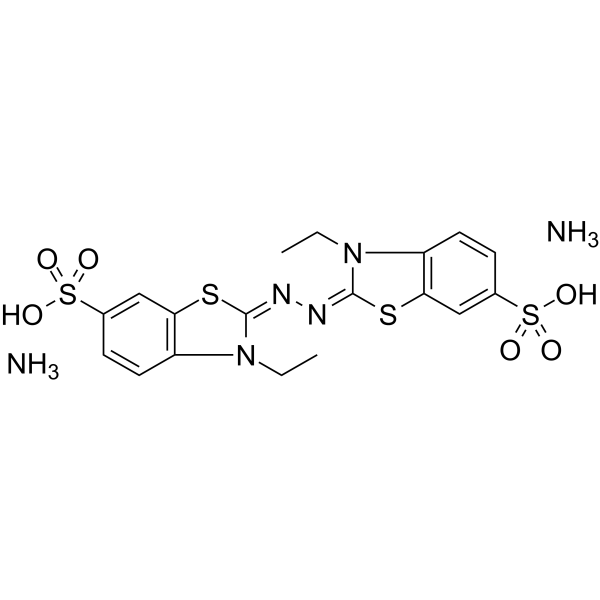ABTS diammonium salt;(Synonyms: AzBTS-(NH4)2) 纯度: 99.25%
ABTS diammonium salt 是一种辣根过氧化物酶 (HRP) 的底物。

ABTS diammonium salt Chemical Structure
CAS No. : 30931-67-0
| 规格 | 价格 | 是否有货 | 数量 |
|---|---|---|---|
| Free Sample (0.1-0.5 mg) | ; | Apply now | ; |
| 10;mM;*;1 mL in DMSO | ¥500 | In-stock | |
| 500 mg | ¥400 | In-stock | |
| 1 g | ¥580 | In-stock | |
| 5 g | ; | 询价 | ; |
| 10 g | ; | 询价 | ; |
* Please select Quantity before adding items.
ABTS diammonium salt 相关产品
bull;相关化合物库:
- Bioactive Compound Library Plus
| 生物活性 |
ABTS diammonium salt is a substrate for horseradish peroxidase (HRP) conjugate. |
||||||||||||||||
|---|---|---|---|---|---|---|---|---|---|---|---|---|---|---|---|---|---|
| 体外研究 (In Vitro) |
A micro-technique of enzyme-linked immunosorbent assay (ELISA) using ABTS, as a substrate for HRP conjugate is studied. In a comparative study among 4 substrates, namely; 5-aminosalicylic acid (5AS), O-phenylenediamine (OPD), O-tolidine (OT) and ABTS, for HRP in terms of sensitivity, ABTS is the most sensitive, stable and the best in visuality by its bluish-green color[1]. ABTS is a typical peroxidase substrate. For purification and characterization peroxidase positive transformants are cultivated in large scale (XL) under conditions that yield active protein in the culture supernatant. After 160 h cultivation an activity of 55,000 U/L in relation to the substrate ABTS is achieved and the supernatant containing the peroxidase is harvested. With ABTS as substrate the peroxidase activity falls significantly when the H2O2 concentration rose above 0.125 mM, indicating that the enzyme is inhibited by H2O2. Maximum reaction rates depending upon substrate tested reache values between 31.2 and 125 µM[2]. MCE has not independently confirmed the accuracy of these methods. They are for reference only. |
||||||||||||||||
| 分子量 |
548.68 |
||||||||||||||||
| Formula |
C18H24N6O6S4 |
||||||||||||||||
| CAS 号 |
30931-67-0 |
||||||||||||||||
| 运输条件 |
Room temperature in continental US; may vary elsewhere. |
||||||||||||||||
| 储存方式 |
4deg;C, sealed storage, away from moisture *In solvent : -80deg;C, 6 months; -20deg;C, 1 month (sealed storage, away from moisture) |
||||||||||||||||
| 溶解性数据 |
In Vitro:;
H2O : ≥ 50 mg/mL (91.13 mM) DMSO : 20.83 mg/mL (37.96 mM; Need ultrasonic) * “≥” means soluble, but saturation unknown. 配制储备液
*
请根据产品在不同溶剂中的溶解度选择合适的溶剂配制储备液;一旦配成溶液,请分装保存,避免反复冻融造成的产品失效。 In Vivo:
请根据您的实验动物和给药方式选择适当的溶解方案。以下溶解方案都请先按照 In Vitro 方式配制澄清的储备液,再依次添加助溶剂: ——为保证实验结果的可靠性,澄清的储备液可以根据储存条件,适当保存;体内实验的工作液,建议您现用现配,当天使用; 以下溶剂前显示的百
|
||||||||||||||||
| 参考文献 |
|
| Kinase Assay [2] |
Enzyme activity is determined photometrically using a temperature controlled multi-mode plate reader or alternatively in a UV/Vis spectrophotometer. Reactions are initiated by addition of the enzyme. Enzyme activity is measured over a period of 10 min at 25°C at the appropriate wavelength for the substrate. One unit (1 U) is defined as the amount of enzyme that converts 1 µmol substrate per minute. Various H2O2 concentrations (0-1250 µM, enzyme concentrations (0.27-54 nM) and substrate concentrations are used to determine the enzyme activity. The activity of rPsaDyP vs ABTS is determined in 100 mM sodium acetate buffer at pH 3.8 and a final H2O2 concentration of 125 µM. Production of the ABTS cation radical is studied at 420 nm (ε420 36,000 L mol-1 cm-1)[2]. MCE has not independently confirmed the accuracy of these methods. They are for reference only. |
|---|---|
| 参考文献 |
|
